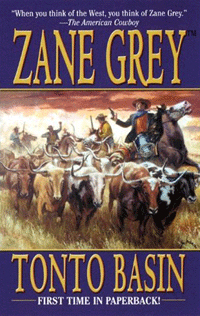Plot summary
The story begins with 24-year-old Jean Isbel in the last stages of a multi-week trip from Oregon to the frontier in Arizona where his family had moved four years earlier to start a cattle ranch. As he nears his destination he meets a woman in the woods, and falls in love at first sight. As they part they learn that they are mortal enemies. She is Ellen Jorth, and her family is locked in a deadly feud with his.
Jean dreads the part his father, Gaston, wants him to play in the feud. He can’t get Ellen out of his mind. They meet again and his words awake in her doubt and fear that her father, Lee Jorth, is not an honorable man but in fact a horse thief and cattle rustler. As events unfold her fears are proved true. Through thick and thin Jean Isbel defends Ellen’s honor and believes the best of her.
The feud erupts into fatal gun battles, first at the Isbel ranch house, and then at the general store in the nearby town. Most of the Isbel and Jorth clans are killed, with several of their allies. The remnant of the Jorths flee with Ellen in tow to a hide-out hidden in a deep box cañon.
Jean and his allies track them and there is a deadly gun battle in the woods nearby. Ellen is forced by one of the three remaining Jorth allies to flee once again. During their flight their horse is shot out from under them. Ellen now on foot meets one of the dying Isbels and finally learns the certain truth that her father, family, and their allies were horse thieves and cattle rustlers as she feared.
When she finally makes her way back to the hide-out, she arrives just after Jean has been forced to take refuge in the loft, unknown to her. One of the two remaining rustlers attacks her with rape in mind but is interrupted by the arrival of the other rustler. Ellen discovers Jean during this interruption. When the rustler returns a few minutes later, Ellen is forced to kill him to protect herself and Jean. A minute later Jean kills the last rustler.
The story ends with Jean and Ellen declaring their love for each other.
Themes
The book is concerned with the destruction deadly violence wreaks on those family members who survive. Grey writes about the intense concern Jean feels for the impact the violence will have on the wives and children whose husbands and fathers will die in the feud.
The feud is caused by a love triangle between Gaston Isbel, Lee Jorth, and Ellen the woman both love, and the mother of Ellen Jorth. The story explores how love, betrayal, and jealousy can engender a hate which leads two men to destroy their families, without a thought to the pain and suffering of those relatives who will be left to bury the dead.
Ellen grows from a naïve girl to a woman of understanding under the severe trial of the events which overtake her. She begins to examine critically her own behavior with wisdom and insight. She grows and matures emotionally and psychologically, becoming aware that her father whom she had supported with unquestioning trust, is in fact a scoundrel, a thief, and a thoroughly dishonorable rogue. At the end she acts decisively and fatally to protect herself, her virtue, and the man she loves.

Tonto Basin is a census-designated place (CDP) in Gila County, Arizona, United States. The population was 1,424 at the 2010 United States Census, up from 840 in 2000.

Pearl Zane Grey was an American author and dentist. He is known for his popular adventure novels and stories associated with the Western genre in literature and the arts; he idealized the American frontier. Riders of the Purple Sage (1912) was his best-selling book.

Riders of the Purple Sage is a Western novel by Zane Grey, first published by Harper & Brothers in 1912. Considered by scholars to have played a significant role in shaping the formula of the popular Western genre, the novel has been called "the most popular western novel of all time".

To the Last Man: A Story of the Pleasant Valley War is a 1921 western novel written by Zane Grey.

To the Last Man is a 1923 American silent Western film based on the 1921 novel by Zane Grey, produced by Adolph Zukor and Jesse L. Lasky from Famous Players–Lasky, distributed by Paramount Pictures, directed by Victor Fleming, and starring Richard Dix, Lois Wilson, and Noah Beery. The cinematographer was James Wong Howe.
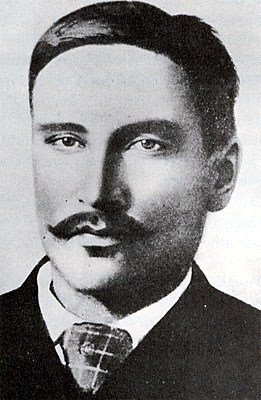
The Pleasant Valley War, sometimes called the Tonto Basin Feud, or Tonto Basin War, or Tewksbury-Graham Feud, was a range war fought in Pleasant Valley, Arizona in the years 1882–1892. The conflict involved two feuding families, the Grahams and the Tewksburys. The Grahams were ranchers, while the Tewksburys, who were part Native American, started their operations as cattle ranchers before branching out to sheep.

Thomas Wakefield Blackburn was an American author, screenwriter and lyricist. His work included various Western novels and television screenplays, as well as the lyrics to "The Ballad of Davy Crockett" and other songs.
In the mid 1950s Blackburn worked in the story department at Walt Disney's studio and it was there, in addition to working on the Davy Crockett films and teleplays, that he also began composing lyrics. Among his most successful efforts are "The Ballad of Davy Crockett" and "Farewell" for that series and "Johnny Tremain" and "The Liberty Tree" for Johnny Tremain.

Forlorn River is a Western novel written by Zane Grey, first published in 1927.
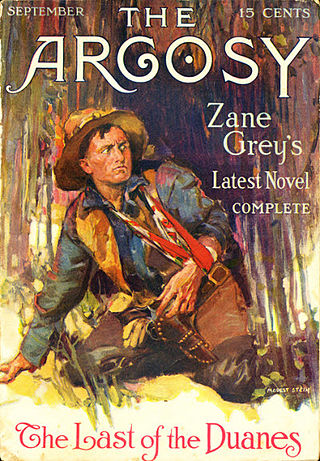
Last of the Duanes is a 1914 novel by Zane Grey.

The Lone Star Ranger is a Western novel published by Zane Grey in 1915. The book takes place in Texas, the Lone Star State, and several main characters are Texan outlaws. It follows the life of Buck Duane, a man who becomes an outlaw and then redeems himself in the eyes of the law.
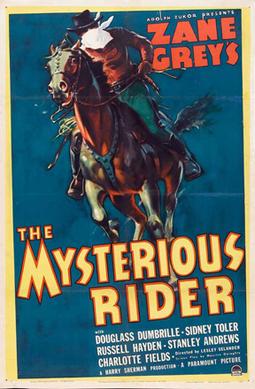
The Mysterious Rider is a 1938 American Western film directed by Lesley Selander and starring Douglass Dumbrille, Sidney Toler, and Russell Hayden. Written by Maurice Geraghty based on the 1921 novel The Mysterious Rider by Zane Gray, the film is about a notorious outlaw who returns to the ranch he once owned and takes a job disguised as a ranch hand. Unrecognized by the ranch's current owner, he waits patiently for an opportunity to expose the men who murdered his partner twenty years ago, framed him for the crime, and then stole his ranch. The film was later released for television in the United States as Mark of the Avenger.

Feuds in the United States deals with the phenomena of historic blood feuding in the United States. These feuds have been numerous and some became quite vicious. Often, a conflict which may have started out as a rivalry between two individuals or families became further escalated into a clan-wide feud or a range war, involving dozens—or even hundreds—of participants. Below are listed some of the most notable blood feuds in United States history, most of which occurred in the Old West.
Gunsmoke: To the Last Man is a 1992 American Western television film starring James Arness as retired Marshal Matt Dillon. It was directed by Jerry Jameson and based upon the long-running American TV series Gunsmoke.

Riders of the Purple Sage is a 1918 American silent Western film directed by Frank Lloyd and starring William Farnum, Mary Mersch, and William Scott. The film is about a former Texas Ranger who goes after a group of Mormons who have abducted his married sister. This Frank Lloyd silent film was the first of five film adaptations of Zane Grey's 1912 novel.
Thunder Mountain is a 1947 American Western film directed by Lew Landers and starring Tim Holt and Martha Hyer. It was the first of Holt's 29 post war Western star vehicles and the first in a series of Zane Grey adaptations he made for RKO. It was also the first film of his written by Norman Houston who would go on to write 19 more for the star.
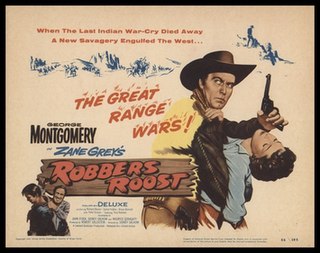
Robbers' Roost is a 1955 American Western film directed by Sidney Salkow and written by John O'Dea, Sidney Salkow and Maurice Geraghty. The film stars George Montgomery, Richard Boone, Sylvia Findley, Bruce Bennett, Peter Graves and Tony Romano. It is based on the 1932 novel Robbers' Roost by Zane Grey. The film was released on May 30, 1955, by United Artists.

Tonto Basin Outlaws is a 1941 American western film directed by S. Roy Luby. The film is the tenth in Monogram Pictures' "Range Busters" series, and it stars Ray "Crash" Corrigan as Crash, John "Dusty" King as Dusty and Max "Alibi" Terhune as Alibi, with Jan Wiley, Tris Coffin and Edmund Cobb. Despite the film's title, the action takes place in Montana, not Arizona's Tonto Basin. Like the other of the Range Busters series, the film was shot at Corriganville Movie Ranch and used footage from silent Westerns.

Thunder River Feud is a 1942 American Western film directed by S. Roy Luby and written by John Vlahos and Earle Snell. The film is the twelfth in Monogram Pictures' "Range Busters" series, and it stars Ray "Crash" Corrigan as Crash, John "Dusty" King as Dusty and Max "Alibi" Terhune as Alibi, with Jan Wiley, Jack Holmes and Rick Anderson. The film was released on January 9, 1942.
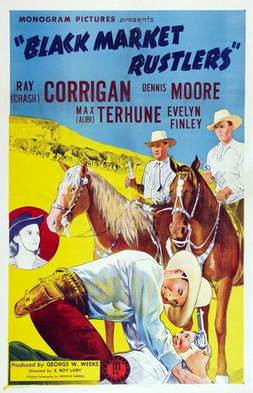
Black Market Rustlers is a 1943 American Western film directed by S. Roy Luby and written by Patricia Harper. The film is the twenty-third in Monogram Pictures' "Range Busters" series, and it stars Ray "Crash" Corrigan as Dusty, Dennis Moore as Denny and Max Terhune as Alibi, with Evelyn Finley, Steve Clark and Glenn Strange. The film was released on August 27, 1943.
George W. Weeks (1885–1953) was an American film producer. During the early 1930s he was involved with Sono Art Pictures and Mayfair Pictures. In the 1940s he released his films, including the Range Busters series featuring Ray "Crash" Corrigan, through Monogram Pictures.
